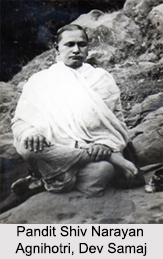 One of the important religious and social movements in Bengal during the British period was the Dev Samaj (Divine Society). The founder of Dev Samaj was Pandit Shiv Narayan Agnihotri or Satyananda Agnihotri. He established it on 16th February, 1887. As Agnihotri was closely associated with the Lahore Brahmo Samaj in his first life, the Dev Samaj was initially thought to be an extension of the Brahmo Samaj. However, the Dev Samaj started to diverge from the doctrines of Brahmo Samaj very soon and also developed its own ideas and philosophy. Satyananda Agnihotri rejected the Brahmo rationalism and instead, he taught that only the guru, in the person of Agnihotri has the capability to provide a path of everlasting delight.
One of the important religious and social movements in Bengal during the British period was the Dev Samaj (Divine Society). The founder of Dev Samaj was Pandit Shiv Narayan Agnihotri or Satyananda Agnihotri. He established it on 16th February, 1887. As Agnihotri was closely associated with the Lahore Brahmo Samaj in his first life, the Dev Samaj was initially thought to be an extension of the Brahmo Samaj. However, the Dev Samaj started to diverge from the doctrines of Brahmo Samaj very soon and also developed its own ideas and philosophy. Satyananda Agnihotri rejected the Brahmo rationalism and instead, he taught that only the guru, in the person of Agnihotri has the capability to provide a path of everlasting delight.
Satyananda Agnihotri was a student of the Thomson College of Engineering at Roorkee and he was introduced to Vedanta through the teachings of Shiv Dayal Singh. While staying at Lahore, he was attracted to the Brahmo Samaj through the influence of his Guru and also of Munshi Kanhyalal Alakhdhari. He joined the Brahmo Samaj in 1873 and soon became one of the most prominent figures in the organisation. He nicely elaborated the rationalistic and eclectic Brahmo doctrine. After getting more involved in the work of Brahmo Samaj, he took a modified Brahmo form of Sanyas on 20th December, 1882 and changed his name to Satyananda Agnihotri. However, as friction developed within the Brahmo Samaj and doubts in the Pandit`s own mind, he resigned from the Punjab Brahmo Samaj in 1886.
After departing from the Brahmo Samaj, Satyananda Agnihotri felt the need of an organisation to propagate his own ideas and he established the Dev Samaj in 1887 to serve this purpose. Agnihotri initiated the dual worship of himself and God in 1892 and three years later, the worship of God was discarded. The Guru became the sole point of attraction for the members of the Dev Samaj. Services of hymns, a sermon and readings from the Deva Shastra were held by the Dev Samaj on a regular basis. The traditional idol of God was replaced by Agnihotri or his portrait.
The Dev Samaj fused traditional concepts with demands for radical social change in its patterns of worship and its ideology. The Samaj propagated a code of honesty in public and private and its members were forbidden to lie, steal, cheat, accept bribes or gamble. The members were also prohibited from taking liquor or drugs and were directed to take strict vegetarian diets. No kinds of adultery, polygamy and `unnatural crimes` were allowed and the main motto of the members` lives was expected to be only to work and live as a householder. Satyananda Agnihotri was called as Dev Bhagwan Atma by his followers.
The Dev Samaj strongly opposed the caste system that was in practice in Hinduism for several centuries. The Samaj directed its members to abandon the caste system and practise inter-caste dining and inter-caste marriage. The Samaj also tried to reassess the role of women in the Indian society and made attempts to eliminate child marriage. The Samaj set the age of marriage at twenty for the boys and sixteen for the girls. Taking excessive dowries, the seclusion of women and their traditional mourning rites were discouraged by the Dev Samaj. The widow remarriage was also acceptable for the members of Dev Samaj and in fact, Satyananda Agnihotri married a widow himself, after the death of his first wife. The Dev Samaj encouraged the education of women as well and opened a co-educational school in Moga (Ferozepore district) on 29th October, 1899.
The Dev Samaj laid emphasis on maintaining a strict moral standard and a significant social radicalism. The Samaj also appealed to the Hindus, graduates, magistrates, doctors, pleaders, money-lenders, landlords and Government servants, who comprised the membership of the Dev Samaj. Most members of the Dev Samaj were well educated and a large percentage of literate women were also associated with the Samaj. The Dev Samaj was actually an acculturative socio-religious movement that drew its support from the highly educated upper caste Hindus. The Dev Samaj produced a great mixture of religious tradition and radical social change and it was especially careful to improve the position and role of women in the Indian society. However, though the Samaj declined after the death of Satyananda Agnihotri, it was not ceased and continued to practise the Vigyan Mulak Dharma (Science Grounded Religion).



















